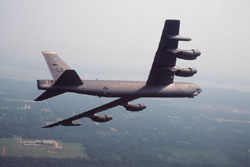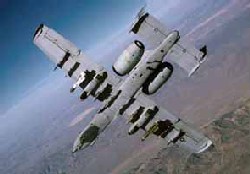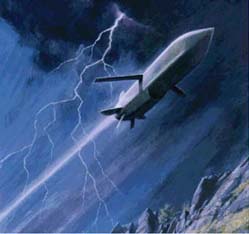Daily News
by Gail Helmer
[ Send Us News | Archives ]
Star Trek: Bridge Commander Demo
Totally Games has released a playable demo of Star Trek: Bridge Commander. The demo includes the introductory cinematics and initial three missions of the full game, along with the Quick Battle mode. Download
MOHAA UK Retail Patch v1.10
2015 and Electronic Arts have issued the UK version 1.10 patch for Medal of Honor: Allied Assault, coinciding with the release of their WWII first-person shooter in that country. As before, it offers an in-game GameSpy server browser, multiplayer cheat protection, enhanced dedicated server control, and networking improvements. Download
Video Game Piracy Totaled Nearly $2 Billion in 2001
The U.S. video game industry lost at least $1.9 billion to global piracy last year, half of which came from Korea and China, an industry trade group said on Thursday. The Washington, D.C.-based Interactive Digital Software Association (IDSA) said its estimate was included in a report the International Intellectual Property Alliance (IIPA) will file with the United States Trade Representative on Friday. [Reuters]
NVidia Profit Jumps, Confirms SEC Inquiry
Graphics chip manufacturer NVidia Corp. Thursday said fourth-quarter profits more than doubled amid strong sales of game consoles and personal computers that use its chips, and raised its financial guidance for the fiscal year. But a disclosure of an internal investigation following a Securities and Exchange Commission inquiry sent Nvidia's shares down sharply in after-hours trade. The stock fell to $57.30 from a close of $62.16 in regular Nasdaq trading. [Reuters]
Military News
Joint Standoff Weapon Completes B-52 Integration Test
Raytheon's Joint Standoff Weapon (JSOW) has completed aircraft integration tests with the US Air Force's B-52 Stratofortress bomber. Two JSOWs were successfully launched from a B-52 over the Naval Air Systems Command western test range complex. Both weapons safely separated from the aircraft, navigated approximately 30 miles to the target area, and dispensed live BLU-97 Combined Effect Munitions (CEM). As planned, the two weapons dispensed their submunitions nearly simultaneously over their respective target areas.

"This is a significant milestone leading to the JSOW-A variant initial operating capability for the B-52," said Col. Kenneth Merchant, programme director for Area Attack Systems Programme Office, Eglin Air Force Base, Fla. "The full rate production weapons used in this test are identical to the ones that will be used on both Air Force and Navy aircraft."
The JSOW family is the new generation glide weapon that allows precision air strike launches from well beyond most enemy air defences. The AGM-154 JSOW is modular in design with variants that integrate different lethal submunitions, as well as a unitary blast/fragmentation and penetrating warhead.
The AGM-154A and AGM-154B have completed Engineering and Manufacturing Development (EMD) and are in production. The AGM-154C, with the unitary warhead, is currently in EMD.
JSOW is currently flying on the F/A-18, F-16 and B-2 aircraft. Other ongoing JSOW integration efforts in addition to the B-52 include the B-1B and the F-15E.
New Simulator Helps Train A-10 Pilots
The 23rd Operations Support Squadron has a new toy. Like a high-tech video game gone serious, the $2.3 million A-10 Thunderbolt II flight simulator helps prepare the pilots who fly the 23rd Fighter Group's combat aircraft. Produced by the Air Force Research Laboratory and Lockheed Martin Technology Services, the Full Mission Trainer emulates A-10 cockpit instruments and visual flight displays to provide a realistic cockpit environment for pilots.
The simulator prepares pilots for combat by allowing them to practice complex emergency procedures, said 2nd Lt. David Jones, the project officer responsible for FMT integration. It simulates situations which peacetime training cannot replicate without unacceptable risk to irreplaceable pilots and aircraft.

Capt. Mike Curley, a 75th Fighter Squadron pilot and instructor, described the simulator as a training enhancement. Pilots can go over certain aspects again and again to help create habits that can save lives and equipment in real-world situations in the air, he said. Curley said the unit is only a small part of a big picture in training pilots.
It will help with "checklist procedures, basic knowledge of systems and 'switchology,'" he said, "but it will not create a superior attack pilot. Actual flying and the application of solid tactics in the air is what creates a superior attack pilot."
The simulator makes it possible for pilots to hone their weapons-delivery skills around the clock using all delivery modes of the A-10 without the need to reserve bombing ranges and airspace or use munitions. Another benefit of the simulator includes the capability for newly assigned pilots to gain familiarity with the local flying area or an overseas theater by using imagery programmed into its database.
Individual pilots can operate it solo or an instructor can generate a scenario and change the situation as it evolves, said Staff Sgt. Jerry Edwards, the noncommissioned officer in charge of simulator operations.
Besides the cockpit itself, key components include an instructor operator station, an image generator, a 215-degree visual display and computer systems to provide appropriate responses to operator inputs. The simulator is scheduled to receive upgrades to include threat-response training and interactive play via other linked trainers. Eventually, commanders may use the simulator to evaluate pilot and unit capabilities to perform their wartime mission, officials said.
Naval Scalp For French Navy
France is to develop a new cruise missile to be deployed by its navy from 2011. The French MOD is planning on a total of 250 missiles, at a cost of euros 785 million ($691 million). 17 of France's new multi-mission frigates will be equipped with them from 2011 as will six Barracuda submarines from 2015.
The Naval Scalp is based on the airborne Scalp EG/Storm Shadow missile. Subassemblies derived directly from the Scalp EG will be used on the Naval Scalp, allowing the new missile to be produced at lower costs and within shorter lead-times than would have been possible if an entirely new missile had had to be developed.

The feasibility phase of the Naval Scalp programme covers technical risk reduction in connection with converting the cruise missiles for vertical launchers or torpedo tubes.
Following the launch by France of the APACHE programme (anti-tank bomblet dispenser missile), the United Kingdom and France decided in 1996 to jointly initiate a programme for the production of the Scalp EG/Storm Shadow cruise missile, and were joined in 1999 by Italy, in an integrated industrial partnership.
"In terms of the impact upon production, the initial total orders, which concerned 100 French Apache missiles, now amount to 2,000 cruise missiles for the armed forces of three European countries: the United Kingdom, France and Italy", declared Pierre Dubois, Director of MBDA France and general manager of the Scalp/Storm Shadow family.
[ Send Us News | Archives ]
by Gail Helmer
Friday February 15, 2002
- Star Trek: Bridge Commander Demo
- MOHAA UK Retail Patch v1.10
- Video Game Piracy Totaled Nearly $2 Billion in 2001
- NVidia Profit Jumps, Confirms SEC Inquiry
- Joint Standoff Weapon Completes B-52 Integration Test
- New Simulator Helps Train A-10 Pilots
- Naval Scalp For French Navy
Star Trek: Bridge Commander Demo
Totally Games has released a playable demo of Star Trek: Bridge Commander. The demo includes the introductory cinematics and initial three missions of the full game, along with the Quick Battle mode. Download
MOHAA UK Retail Patch v1.10
2015 and Electronic Arts have issued the UK version 1.10 patch for Medal of Honor: Allied Assault, coinciding with the release of their WWII first-person shooter in that country. As before, it offers an in-game GameSpy server browser, multiplayer cheat protection, enhanced dedicated server control, and networking improvements. Download
Video Game Piracy Totaled Nearly $2 Billion in 2001
The U.S. video game industry lost at least $1.9 billion to global piracy last year, half of which came from Korea and China, an industry trade group said on Thursday. The Washington, D.C.-based Interactive Digital Software Association (IDSA) said its estimate was included in a report the International Intellectual Property Alliance (IIPA) will file with the United States Trade Representative on Friday. [Reuters]
NVidia Profit Jumps, Confirms SEC Inquiry
Graphics chip manufacturer NVidia Corp. Thursday said fourth-quarter profits more than doubled amid strong sales of game consoles and personal computers that use its chips, and raised its financial guidance for the fiscal year. But a disclosure of an internal investigation following a Securities and Exchange Commission inquiry sent Nvidia's shares down sharply in after-hours trade. The stock fell to $57.30 from a close of $62.16 in regular Nasdaq trading. [Reuters]
Military News
Joint Standoff Weapon Completes B-52 Integration Test
Raytheon's Joint Standoff Weapon (JSOW) has completed aircraft integration tests with the US Air Force's B-52 Stratofortress bomber. Two JSOWs were successfully launched from a B-52 over the Naval Air Systems Command western test range complex. Both weapons safely separated from the aircraft, navigated approximately 30 miles to the target area, and dispensed live BLU-97 Combined Effect Munitions (CEM). As planned, the two weapons dispensed their submunitions nearly simultaneously over their respective target areas.

"This is a significant milestone leading to the JSOW-A variant initial operating capability for the B-52," said Col. Kenneth Merchant, programme director for Area Attack Systems Programme Office, Eglin Air Force Base, Fla. "The full rate production weapons used in this test are identical to the ones that will be used on both Air Force and Navy aircraft."
The JSOW family is the new generation glide weapon that allows precision air strike launches from well beyond most enemy air defences. The AGM-154 JSOW is modular in design with variants that integrate different lethal submunitions, as well as a unitary blast/fragmentation and penetrating warhead.
The AGM-154A and AGM-154B have completed Engineering and Manufacturing Development (EMD) and are in production. The AGM-154C, with the unitary warhead, is currently in EMD.
JSOW is currently flying on the F/A-18, F-16 and B-2 aircraft. Other ongoing JSOW integration efforts in addition to the B-52 include the B-1B and the F-15E.
New Simulator Helps Train A-10 Pilots
The 23rd Operations Support Squadron has a new toy. Like a high-tech video game gone serious, the $2.3 million A-10 Thunderbolt II flight simulator helps prepare the pilots who fly the 23rd Fighter Group's combat aircraft. Produced by the Air Force Research Laboratory and Lockheed Martin Technology Services, the Full Mission Trainer emulates A-10 cockpit instruments and visual flight displays to provide a realistic cockpit environment for pilots.
The simulator prepares pilots for combat by allowing them to practice complex emergency procedures, said 2nd Lt. David Jones, the project officer responsible for FMT integration. It simulates situations which peacetime training cannot replicate without unacceptable risk to irreplaceable pilots and aircraft.

Capt. Mike Curley, a 75th Fighter Squadron pilot and instructor, described the simulator as a training enhancement. Pilots can go over certain aspects again and again to help create habits that can save lives and equipment in real-world situations in the air, he said. Curley said the unit is only a small part of a big picture in training pilots.
It will help with "checklist procedures, basic knowledge of systems and 'switchology,'" he said, "but it will not create a superior attack pilot. Actual flying and the application of solid tactics in the air is what creates a superior attack pilot."
The simulator makes it possible for pilots to hone their weapons-delivery skills around the clock using all delivery modes of the A-10 without the need to reserve bombing ranges and airspace or use munitions. Another benefit of the simulator includes the capability for newly assigned pilots to gain familiarity with the local flying area or an overseas theater by using imagery programmed into its database.
Individual pilots can operate it solo or an instructor can generate a scenario and change the situation as it evolves, said Staff Sgt. Jerry Edwards, the noncommissioned officer in charge of simulator operations.
Besides the cockpit itself, key components include an instructor operator station, an image generator, a 215-degree visual display and computer systems to provide appropriate responses to operator inputs. The simulator is scheduled to receive upgrades to include threat-response training and interactive play via other linked trainers. Eventually, commanders may use the simulator to evaluate pilot and unit capabilities to perform their wartime mission, officials said.
Naval Scalp For French Navy
France is to develop a new cruise missile to be deployed by its navy from 2011. The French MOD is planning on a total of 250 missiles, at a cost of euros 785 million ($691 million). 17 of France's new multi-mission frigates will be equipped with them from 2011 as will six Barracuda submarines from 2015.
The Naval Scalp is based on the airborne Scalp EG/Storm Shadow missile. Subassemblies derived directly from the Scalp EG will be used on the Naval Scalp, allowing the new missile to be produced at lower costs and within shorter lead-times than would have been possible if an entirely new missile had had to be developed.

The feasibility phase of the Naval Scalp programme covers technical risk reduction in connection with converting the cruise missiles for vertical launchers or torpedo tubes.
Following the launch by France of the APACHE programme (anti-tank bomblet dispenser missile), the United Kingdom and France decided in 1996 to jointly initiate a programme for the production of the Scalp EG/Storm Shadow cruise missile, and were joined in 1999 by Italy, in an integrated industrial partnership.
"In terms of the impact upon production, the initial total orders, which concerned 100 French Apache missiles, now amount to 2,000 cruise missiles for the armed forces of three European countries: the United Kingdom, France and Italy", declared Pierre Dubois, Director of MBDA France and general manager of the Scalp/Storm Shadow family.
